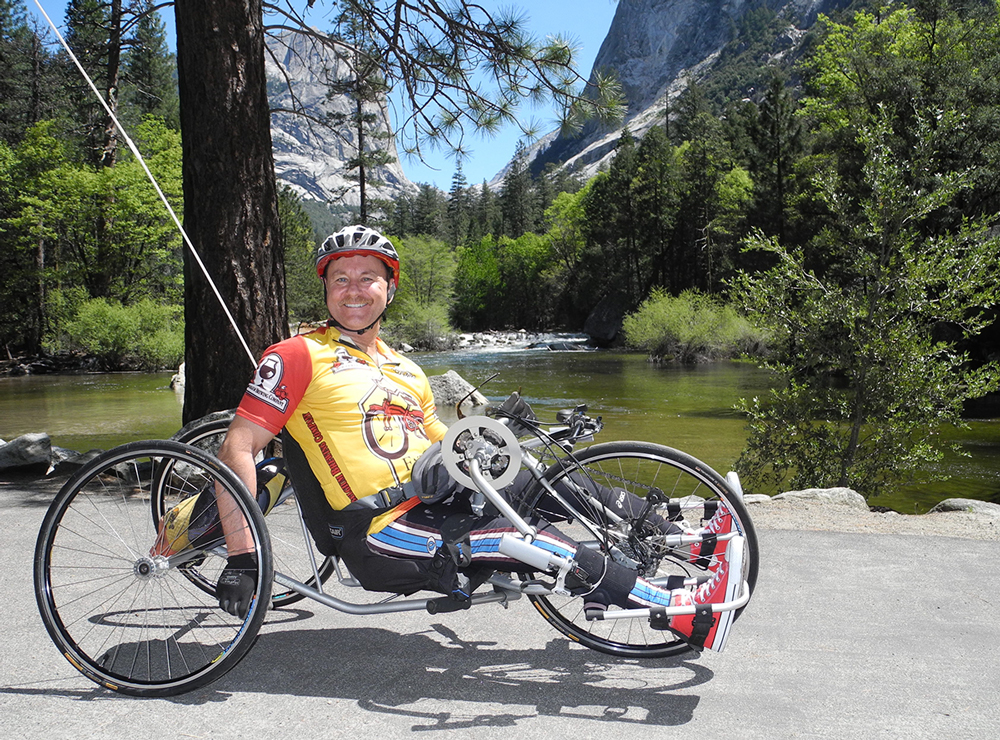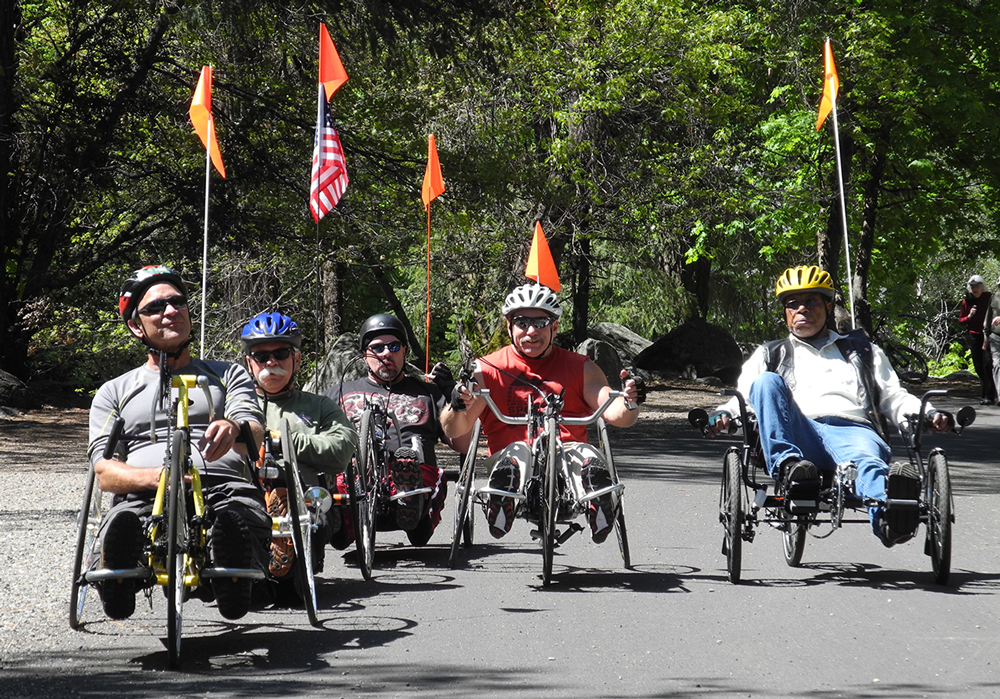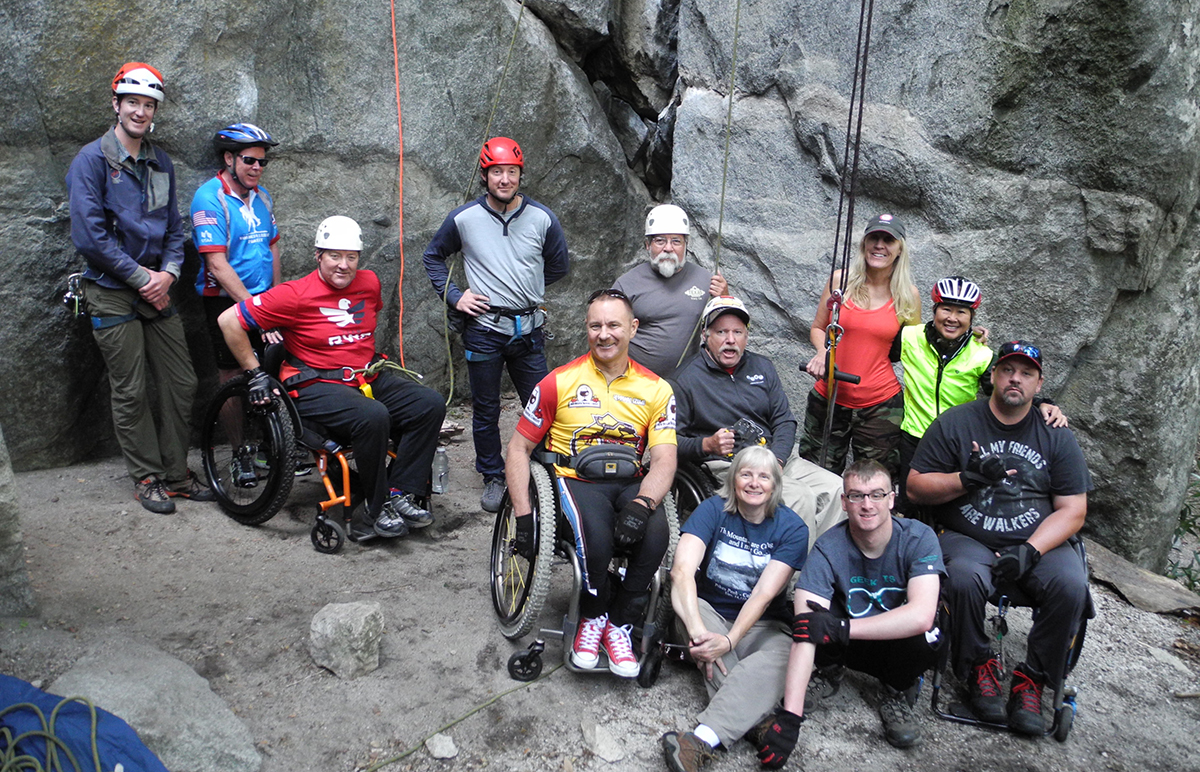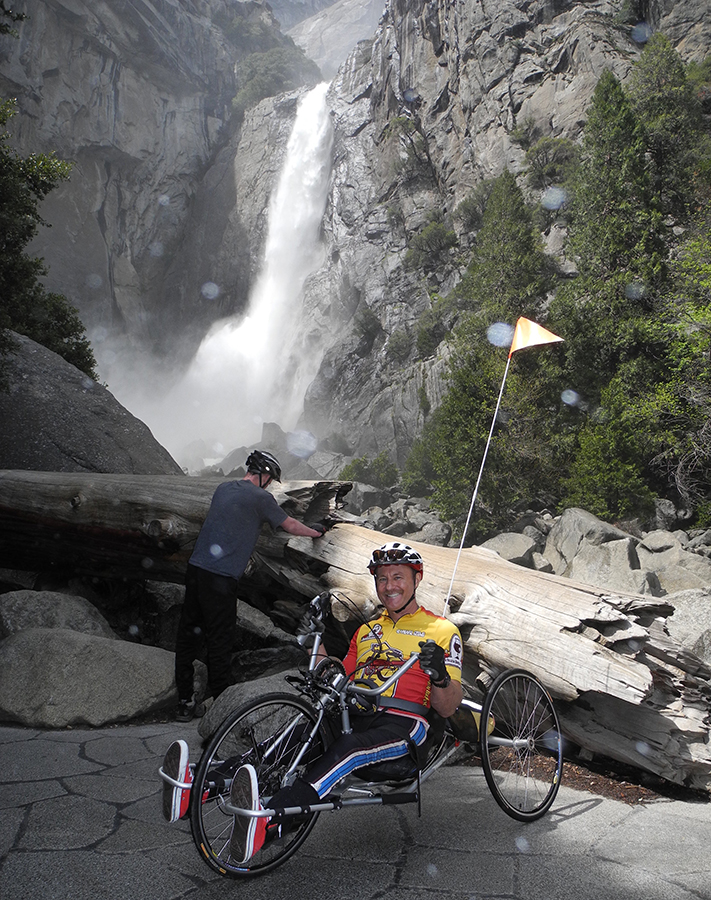Rock ‘n Roll adaptive cycling camp in Yosemite
Crossing over a lush grassy meadow on my handcycle, I stop on the wooden walkway to take in my surroundings — new spring growth on the trees juxtaposed with the sun’s illumination of giant granite walls. The thunderous sound of Yosemite Falls drifts in and out with the shifting breeze as I reflect on the past four days of adventure, scenery, friendship and the outstanding accessibility of this iconic national park in the Sierra Nevada mountains of California.

By Bob Vogel, New Mobility October 3, 2016
I had joined 12 other participants for the 10th annual Rock ’n Roll Yosemite adaptive cycling camp, held on May 9-12 and hosted by the City of Sacramento, Department of Parks and Recreation, Access Leisure section, through their Paralympic Sport Sacramento club program. I had been hearing great things about this camp for years — for many wheelers it has become an annual rite — and now I knew why.
The camp, held each year in early May when waterfalls are at their peak and park attendance is moderate, is the brainchild of Rick Mason, the cycling coordinator for Access Leisure. “I got the idea during a visit to Yosemite one spring after a heavy snow year promised spectacular waterfall displays,” says Mason, 58, in his 40th year as a C6-7 quadriplegic. “I brought my handcycle and found there are bike and walking trails throughout the valley floor, and it is the perfect way to explore the area.”
| Accessible Cabins and Trails |
Mason’s event, structured around aspects of camping, is designed to enable a wide range of adaptive cyclists to participate. This includes choosing Housekeeping Camp as basecamp because it has tent cabins — three walled structures with a tent roof and beds that are wheelchair height. Also, the nearby accessible bathrooms have roll-in showers with pull-down benches.
“I chose this campground because it has the benefits of camping without having to set up tents and transfer to the ground,” says Mason. “We had eight people the first year, they had a great time, and the rest is history.”
Since eating well is another component of a successful camping trip, but taxing to prepare after a long day of riding, the event included delicious meals prepared by a camp chef.
Each day consisted of a morning and afternoon ride ranging from seven to 15 miles to explore different parts of the valley, guided by Mark Wellman, a former Yosemite park ranger. Wellman, in his 34th year as a T12 para, is best known for climbing Yosemite’s famous rock faces, El Capitan and Half Dome. He now conducts adaptive climbing clinics around the country and has created adaptive climbing gear to accommodate a wide range of disabilities.
During the rides, Wellman explained the geology and history of the park and stopped to point out well-known sites, including Glacier Point, the start of the John Muir trail and, of course, El Capitan and Half Dome. He shared stories and information from his days as a ranger and what it was like to climb the famous monoliths, including how he and his partner got pinned down by storms on Half Dome and a planned nine-day climb ended up taking 13 days, the last of which was done with no food or water.
Wellman also pointed out features that many people miss in their cars but can be fully appreciated from a handcycle, including Bridal Veil Falls, Ribbon Falls and Sentinel Rock.
All the trails we rode on are ADA compliant. Also, the valley has several roads that are marked “shuttle bus only,” but are open to vehicles showing an accessible placard or accessible plates, as well as to cyclists and hand cyclists. There are accessible walking trails next to the roads.

The experience of having a disability, along with sharing adventures in such a beautiful place, meant the quick formation of common bonds. New Mobility
| Disability Creates a Common Bond |
Late afternoons and evenings were for socializing and reliving the day’s activities. “This is my fifth year participating in the event,” says Lynn Murray, 70, a T10 complete para since 2004. “In addition to the beauty and accessibility of the park, the attraction for me is meeting up with old buddies. Even more cool is meeting new people and hearing everybody’s stories. This event attracts people who are making the most of life with a disability, creating a very positive vibe that adds to the experience.”
Many of the participants had different disabilities, plus there was a mix of veterans and non-vets. Yet, the experience of having a disability, along with sharing adventures in such a beautiful place, meant the quick formation of common bonds.
“It was interesting to see how we all got to know each other during the event,” says Margie Donovan, 54, who worked as a Veterans Affairs visual impairment service coordinator at the San Francisco VA hospital. She has been blind since age 14, and cycles by riding on the back of a tandem bike. “It was obvious that most of the participants were not familiar with folks who are blind, as the first night everybody was overly helpful. By the second night I went up and got my food, and people just continued their conversation, which is what I want — if I need help I will ask.”
At first, the military veterans seemed to gather together in one area, sharing stories about their experiences with the VA. But within 24 hours, vets and non-veterans integrated and began sharing stories about their disability experiences.
This is Army veteran Marv Tuttle’s fifth Rock ’n Roll event. “I keep coming back for the camaraderie,” says Tuttle, 66, a T12 para for 18 years. “All veterans share a common thread that a civilian will never know, and I hope they never have to know, just like people with disabilities share a common thread that nondisabled people will never know. We are all in the same boat, whether we are military or non-military, which makes it easier to form lasting bonds.”
Evenings also included speeches and video presentations — projected on a sheet hung from a clothing line — about other forms of adaptive sports as well as a viewing of Crank it Up, an off-road handcycle documentary produced by Wellman.
Those of us who stayed up a bit later were treated to a star-filled sky, silhouetted by the surrounding granite walls and peaks.

The group prepares to climb Chapel Wall with Mark Wellman’s adaptive climbing system, which supports the climber via a seat and chest harness. Climbers ascend with a pull-up bar using pulley systems that require them to lift a fraction of their weight. New Mobility
| Rock Climbing and Water Falls |
On the third day, Wellman brought out his adaptive climbing gear and a few local guides set up a route for us on Chapel Wall. “The route was much higher than my portable climbing wall, and included the opportunity to check out a portaledge, which is the cot climbers sleep on during multi-day climbs,” says Wellman.
“Climbing on real rock, being up a lot higher than the portable climbing wall is very cool,” says Michael Jorgenson, 50, an L1 complete para for 31 years. “Especially sitting on the portaledge imagining trying to get a good night’s sleep 1,500 feet off the ground.” An Army vet from Kerman, California, Jorgenson enjoyed his second year at the event.
Another highlight of the day was riding close enough to the base of Yosemite Falls to be overwhelmed by the roar of water. We were blasted by mist and high-speed winds emanating from the cascade of water completing its 2,500-foot descent down the granite wall.
Donovan had never been to Yosemite before and found it phenomenal. “For me, being blind, the smells and sounds, the textures under my feet when I was walking … it was incredible,” she says. “Especially the thundering sound from Yosemite Falls, as well as riding by the Merced River, and the long ride going by Bridal Veil Falls. I love water, so that was especially great.”
The event was probably best summed up by Reese Levasseur, 42, an L1 incomplete para. “It was awesome, beautiful. There was adventure, great camaraderie, and it was great to be around a group of people with disabilities that are enthusiastic about handcycling as well as seeing other things that are possible,” says the former Marine sergeant from Vallejo, California. Then he added a sentiment everybody felt while packing up on the final day. “If I get the chance to do the Yosemite ride again, I will for sure.”
| Resources |
| Access Leisure and Paralympic Sport Club. For information regarding camps and Paralympic sports, email Jenny Yarrow, Program Coordinator or phone 916-808-6017 Housekeeping Camp Mark Wellman climbing clinics and adaptive climbing gear |
This event was funded in part by a grant from the United States Department of Veterans Affairs. The opinions, findings and conclusions stated herein are those of the author and do not necessarily reflect those of the United States Department of Veterans Affairs.

The author especially enjoyed the spring waterfall at Lower Yosemite Falls Outlook. New Mobility
| Yosemite Access and other information |
Access in Yosemite Valley is, in a word, outstanding. All of the trails we handcycled on meet ADA guidelines, including the trail to the base of Lower Yosemite Falls. This means everywhere we visited is accessible by manual or power wheelchair.
The $30 per car entrance fee is waived with an America the Beautiful access pass, which is a free lifetime pass to U.S. citizens who have a permanent disability. And for those wheelchair users who want to explore the park but prefer not to drive, there are free shuttle buses that make regular stops at points of interest — all equipped with wheelchair lifts and tie downs.
If you want to explore by handcycle but don’t have one, there is at least one handcycle for rent at the Curry Village rental stands. Reservations are highly recommended: call 209/372-8319 or 209/372-1208.
Lodging options in the valley range from tent cabins to the luxurious “Majestic Yosemite Hotel.”
Yosemite Valley has three campgrounds with accessible camping sites: Lower Pines, Upper Pines, and North Pines. Some of the campsites have a raised tent pad. There are also accessible campsites in more remote parts of the park, outside the valley. For more information, check the Yosemite Accessibility Guide. Advance reservations are highly recommended for camping or lodging, especially May through September.
Yosemite National Park is open all year, and the best month to visit is May, when waterfalls and spring foliage are at their peak. Also late September and October are great months, since that is when changing leaves turn the valley into a riot of color. These months are also quieter in terms of number of visitors. From Memorial Day to Labor Day the park gets extremely busy.
Although there is more than enough scenic beauty and activities to occupy four days in Yosemite Valley, if you have extra time, be sure to take the drive up to Glacier Point for an accessible bird’s eye view of the valley. Another cool option is to take a day trip over scenic Tioga pass (Highway 120), which meanders through high alpine meadows before a steep descent into Lee Vining and Mono Lake.
| Resources |
| America The Beautiful Pass Info PDF Lodging Options Yosemite Accessibility Guide PDF |
![]() Source New Mobility
Source New Mobility
